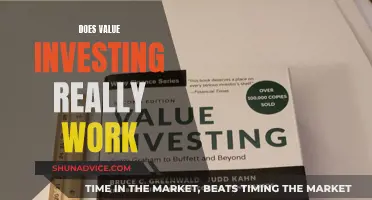
Investing a retirement lump sum is a big decision that can be tricky to navigate. There are two main options for investing a lump sum pension payout: rolling the funds into an IRA and purchasing an immediate annuity, or building an investment portfolio. Both options have their own advantages and disadvantages, and it's important to carefully consider your financial goals, risk tolerance, and current financial situation before making a decision. Seeking the guidance of a financial advisor can be helpful in creating a financial plan that aligns with your retirement goals.
| Characteristics | Values |
|---|---|
| Reasons for taking a lump sum pension payout | Flexibility, less risk for spouses, investment strategy |
| Investment options | Roll funds into an IRA, build an investment portfolio |
| Steps to building an investment portfolio | Roll the lump sum into an IRA, determine ideal asset allocation, buy assets |
| Pros of lump sum investing | Maximizes time in the market, no constant need to add to your portfolio, only pay brokerage fees/commissions once |
| Cons of lump sum investing | Potential for short-term losses, higher exposure to a sudden market crash |
| Factors to consider when choosing between a lump sum or annuity | Life expectancy, income needs, risk, credit quality, inflation, convenience, cost comparison, taxes, gift and estate planning |
What You'll Learn

Weigh up the pros and cons of lump-sum investing
Lump-sum investing is when you take a large amount of money and invest it all at once. This could be a sum of $10,000, $50,000, $200,000 or more, depending on your situation. There are several advantages to this strategy, but also some drawbacks to consider.
Pros of lump-sum investing:
- Higher potential returns: The longer you are invested, the more time compound interest has to increase your returns. Investing a lump sum immediately gives more time for compound interest to work and potentially increase your overall returns.
- No need to time the market: Timing the market is difficult and stressful. Investing a lump sum means you only enter the market once, removing the anxiety and time spent on market research.
- Puts money to work immediately: Money that is not invested is losing value due to inflation. Investing a lump sum gets your money working for you right away, potentially paying bigger dividends over time.
- Only one brokerage fee: With a lump-sum investment, you only pay brokerage fees once, which can save you money.
- 'Set it and forget it': With a lump-sum investment, you can simply buy your investments and be done. There is no need to constantly remember to add to your portfolio, and you can avoid the stress of day-to-day market fluctuations.
Cons of lump-sum investing:
- Difficulty in raising a lump sum: Not all investors have a large sum of cash readily available. It can take time to accumulate a lump sum, which negates one of the benefits of lump-sum investing – getting invested as soon as possible.
- Possible portfolio loss: Investing a lump sum all at once means you could be putting your money in right before a market correction or bear market. This can be emotionally challenging, and if you're not disciplined, you might be tempted to pull your money out, locking in losses.
- Volatility exposure: When you invest a lump sum, even a modest sell-off in the market can be frightening. For example, a 10% drop in the market would result in a $20,000 loss on a $200,000 investment.
- Not a 401(k) replacement: For most Americans, a 401(k) or similar retirement plan is the best option for building a nest egg. These plans offer tax deductions on contributions and tax-deferred growth, as well as employer matching contributions, which is essentially "free money".
- Possible impulsive picks: Investing a lump sum all at once may lead to impulsive stock picks, such as investing in volatile meme stocks. These may not be stocks you want to hold for the long term, and you may not be able to prune them from your portfolio quickly enough if they start to crash.
Lump-sum investing can be a good strategy for some investors, but it is not suitable for everyone. It is important to carefully consider your financial situation, risk tolerance, and investment objectives before deciding whether to invest a lump sum.
Bloom Investing: Is it Free to Access?
You may want to see also

Understand the benefits of dollar-cost averaging
Dollar-cost averaging is a strategy that can help investors manage risk and reduce the impact of market volatility on their portfolios. It involves investing a fixed amount of money into an investment at regular intervals, such as monthly or bi-weekly, rather than investing a lump sum all at once. This strategy is commonly used in retirement plans such as 401(k)s, where individuals contribute a set percentage of their income at regular pay periods.
- Reducing emotional reactions: Dollar-cost averaging helps take the emotion out of investing by removing the stress of trying to time the market. It involves investing a consistent amount regardless of market fluctuations, reducing the impact of sudden price drops or rises.
- Minimizing the impact of bad market timing: The strategy smooths out how market fluctuations affect an investor's portfolio. By investing at regular intervals, individuals avoid putting all their money into an investment right before a market downturn.
- Suitability for long-term investors: Dollar-cost averaging is designed for investors who are in it for the long haul and can be a good strategy for those who don't have a large lump sum to invest all at once. It helps investors accumulate investments over time.
- Psychological benefits: Dollar-cost averaging helps investors become comfortable with uncertainty and market fluctuations. It removes the regret of not timing the purchase perfectly and reduces decision fatigue by creating a predetermined and automatic investment habit.
- Better returns without extra risk: Dollar-cost averaging can boost returns without taking on extra risk. By buying at regular intervals, investors buy more shares when prices are low and fewer shares when prices are high, resulting in a lower average price per share over time.
- Dealing with volatile markets: In a volatile market, dollar-cost averaging allows investors to ignore emotional highs and lows, buying more shares when prices are down and fewer when they are up. This strategy can be particularly powerful in recessions and bear markets, as it ensures investors are buying when the market is down.
Wealthy Investing: Should They Continue?
You may want to see also

Explore investment portfolios
When it comes to investing a lump sum for retirement, there are a variety of options to consider for your investment portfolio. Here are some detailed pointers to help you explore and build an investment portfolio:
Diversification
Diversification is a key strategy when building an investment portfolio. This means spreading your investments across different asset types, sectors, and regions to reduce risk. Different assets, such as shares, bonds, exchange-traded funds (ETFs), mutual funds, commodities, futures, options, and real estate, tend to perform differently in various economic conditions. By diversifying, you can soften the impact of losses in one part of your portfolio and generate more stable and reliable investment returns.
Risk Tolerance and Time Horizon
Your investment portfolio should align with your risk tolerance and time horizon. As a retiree, you likely have a lower risk tolerance, preferring capital preservation and income generation over high-risk, high-reward investments. Your time horizon also changes throughout your lifetime. When you're younger, you might focus on growth investments, but as you approach retirement age, you may need to shift towards less risky investments like fixed-income securities.
Active vs. Passive Management
When deciding between active and passive portfolio management, it's important to understand the differences. Active management often results in higher investment returns but also incurs higher transaction fees. On the other hand, passive management, such as investing in index funds, typically has lower fees but may offer more limited returns.
Retirement Accounts and Tax Efficiency
Consider utilising retirement accounts, such as employer-sponsored plans (e.g., 401(k)s), IRAs (traditional, Roth, SEP, SIMPLE), and taxable brokerage accounts. These accounts offer tax advantages that can boost your investment returns over time. Additionally, investing in an individual savings account (ISA) can provide tax efficiency, allowing your money to grow free from income tax on dividends or interest received.
Dollar-Cost Averaging vs. Lump Sum Investing
Another consideration is whether to invest your lump sum all at once or gradually over time through dollar-cost averaging. Dollar-cost averaging involves investing a fixed sum of money in a stock or fund at regular intervals, regardless of market performance. This strategy averages out the cost per share over time, reducing risk. However, lump sum investing allows more of your money to grow or compound but comes with the risk of potential market downturns.
Mutual Funds
Mutual funds are a popular option for lump-sum retirement investments due to their high liquidity and diversification benefits. They pool money from multiple investors to purchase securities in various investments, such as stocks and bonds. While mutual funds carry risks, they are diverse enough to weather some financial storms, and they offer affordable ways to spread your investments across different industries.
Annuities
Annuities are another popular choice for retirees, providing long-term stability. With an immediate annuity, you make a lump sum premium payment and receive guaranteed distribution payments for a specified period, which can be for a lifetime. Annuities funded by tax-deferred accounts are only taxed on the distributions as you receive them, allowing more of your money to grow tax-deferred.
Real Estate
Investing in real estate can provide the benefit of a diversified portfolio and help keep up with inflation. You can consider purchasing private mortgage lending pool shares to fund property flips or direct investment by buying and renting or flipping properties yourself. Real estate tends to keep pace with inflation, protecting your buying power during retirement.
Remember, it's always a good idea to consult a financial advisor to help you create a financial plan that aligns with your retirement goals, risk tolerance, and time horizon. They can guide you in making fiscally responsible decisions and maximising your lump sum for a comfortable retirement.
Quarterly Payouts: Exploring Investments with Regular Dividend Schedules
You may want to see also

Consider an annuity
Annuities are a common option for retirees who want to invest a lump sum pension payout. An annuity is an insurance contract that provides the buyer with a regular series of payments in return for a lump-sum payment. Annuities are typically used to establish a steady stream of income in retirement.
There are three main types of annuities: immediate or deferred, and fixed, variable, or indexed. The type of annuity you choose will depend on your financial goals and risk tolerance.
With an immediate annuity, you can convert a lump sum into cash flows from day one. A deferred annuity, on the other hand, has an accumulation phase followed by a disbursement (annuitization) phase. Deferred income annuities don't begin paying out after the initial investment. Instead, the client specifies an age at which they would like to begin receiving payments from the insurance company.
Fixed annuities provide a guaranteed minimum rate of interest and fixed periodic payments to the annuitant. Variable annuities allow the owner to receive larger future payments if the annuity fund performs well and smaller payments if its investments perform poorly. Indexed annuities are fixed annuities that provide a return based on the performance of an equity index, such as the S&P 500.
When considering an annuity, it's important to keep in mind that annuities are illiquid and withdrawals are subject to penalties. Additionally, annuities can be complex and costly, so be sure to do your research and understand all fees, charges, and potential penalties before investing.
The Great Debate: Paying Off Your Home vs. Investing — Which Should You Choose?
You may want to see also

Consult a financial advisor
Investing a retirement lump sum is a complex process that depends on your financial situation, goals, and risk tolerance. While you can choose to invest it all at once or gradually over time, it is always recommended to consult a financial advisor to make an informed decision that aligns with your retirement goals. Here are some reasons why seeking professional advice is beneficial:
Understanding Your Financial Situation and Goals:
A financial advisor will take the time to understand your financial circumstances, including your income, expenses, and retirement goals. They will assess your risk tolerance, financial personality, and values to tailor an investment strategy that fits your needs. By asking thoughtful questions, they can guide you in defining clear and realistic financial objectives.
Developing a Comprehensive Financial Plan:
Based on your financial situation and goals, a financial advisor can create a comprehensive plan for your retirement. This plan will consider your short-term and long-term needs, taking into account factors such as liquidity, longevity, and legacy planning. They will help you make informed decisions about investing your lump sum, including the potential trade-offs and risks involved.
Expertise in Investment Strategies:
Financial advisors are well-versed in various investment strategies and can provide valuable insights. They can explain the differences between investing a lump sum immediately or gradually (dollar-cost averaging). Advisors can also help you explore different investment options, such as rolling your lump sum into an IRA, purchasing an annuity, or building an investment portfolio. They will consider factors like market trends, risk management, and diversification to develop a strategy that aligns with your risk tolerance and goals.
Risk Management and Peace of Mind:
Investing a retirement lump sum carries inherent risks, and a financial advisor can help you navigate these potential pitfalls. They will ensure that your investment strategy considers your risk tolerance and financial goals. By performing thorough analyses and providing ongoing monitoring, they can help you avoid emotional decision-making and costly mistakes. Working with an advisor can give you peace of mind, knowing that your investments are being managed by a professional.
Ongoing Support and Guidance:
Consulting a financial advisor is not a one-time event. They provide ongoing support and guidance throughout your retirement journey. They can help you navigate life changes, market fluctuations, and economic shifts. Advisors also assist in rebalancing your portfolio over time, ensuring that it remains aligned with your risk tolerance and goals. Additionally, they can offer valuable insights into tax implications, estate planning, and legacy goals, ensuring that your financial strategy is comprehensive and up-to-date.
While investing a retirement lump sum may seem daunting, consulting a financial advisor can provide you with the expertise, guidance, and peace of mind you need to make informed decisions. They will help you navigate the complexities of investing, ensuring that your retirement goals remain on track. Remember, it's never too early or too late to seek professional financial advice to secure your financial future.
Starbucks: A Brew Worth Betting On
You may want to see also
Frequently asked questions
There are three common reasons employees consider taking a lump sum pension payout: flexibility, less risk for spouses, and investment strategy. Flexibility means you have access to cash you may need to make big purchases in retirement. If one spouse dies, the pension may stop, which could put the surviving spouse in a difficult financial situation. Taking a lump sum gives you more control over your investments.
Lump sum investing maximises time in the market. The longer you are invested in great, market-beating companies, the better your portfolio will do. There is also less anxiety involved with lump sum investing as you don't have to constantly remember to add to your portfolio.
If the market goes down from day one, your entire investment will go down as well, and you will have missed a lot of opportunities to buy in at a better price. Lump sum investing can also be more stressful and lead to short-term losses.







